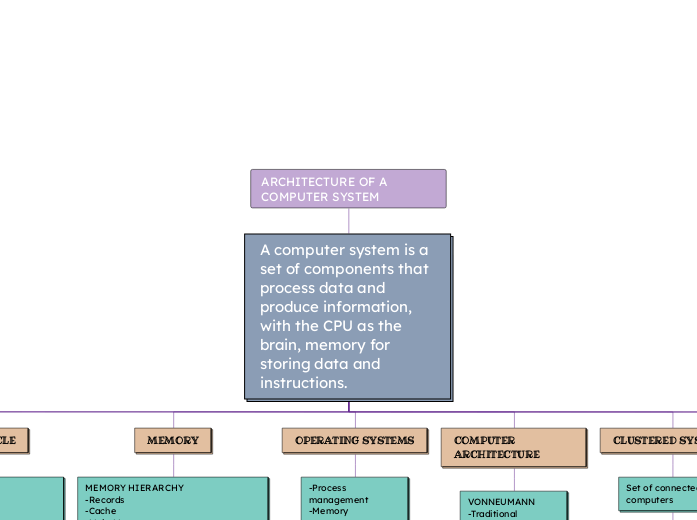ARCHITECTURE OF A COMPUTER SYSTEM
A computer system is a set of components that process data and produce information, with the CPU as the brain, memory for storing data and instructions.
KEY COMPONENTS
CPU -Logical arithmetic unit -Control unit -Registrations
MEMORY -Random access memory -Reading-only memory -caché
INPUT/OUTPUT DEVICES --keyboard,mouse,scanner -monitor,printer -hard disks,optical drives -networks
BUSES
communication channels between components
TYPES -system buses -expansion buses
FUNCTIONS - data, address and control signal transport
TRAINING CYCLE
PHASES -Instruction search -Decoding -Execution -Storage
Interruptions -Hardware -Software
MEMORY
MEMORY HIERARCHY -Records -Cache -Main Memory -Secondary Memory
Memory Management -Memory Allocation -Pagination -Segmentation
OPERATING SYSTEMS
-Process management -Memory management -File system
TYPES -Monotasking -Multitasking -Real Time
COMPUTER ARCHITECTURE
VONNEUMANN -Traditional architecture
Harvard -Separation between data and instructions
RISC -Reduced set of instructions
CISC -complex set of instructions
CLUSTERED SYSTEMS
Set of connected computers
TYPES -High availability -Enhanced performance -Parallel computing
DIRECT MEMORY ACCESS
Data transfer without CPU intervention
PROCESS -DMA request -Data transfer -Interruption at completion
SWITCH-BASED ARCHITECTURES
Use of switches to interconnect components
ADVANTAGES -Higher bandwidth -Lower latency -More scalability
Security
Control de acceso
Only authorized personnel allowed
